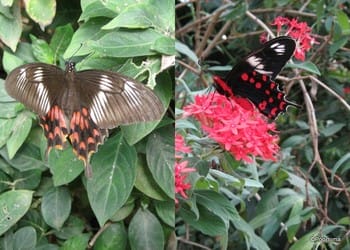The Butterfly Park in Bannerghatta National Park is a three dome structure that can be seen on the return path of the zoological reserve’s safari rides, which is how I first came to know of its existence. Established more than three years back, it’s one of the butterfly conservatories in the country. The park opens to a neat stone pathway, greenery all around, with the chirping of birds and the distant trumpeting of elephants providing a background while walking up to the butterfly conservatory. That’s when it seems like you’ve stepped into a bubble out of this world.

Common Mormon female (left) mimics the inedible species Common Rose to escape from being eaten by predators. The mimics are black bodied and appear dull when compared with the models which are red bodied. Pic: Poornima Sivanandam.
The conservatory creates the right environment for butterflies in the form of a high dome that lets sunshine stream in all day and with plants required to support various species. There is even a small artificial waterfalls falling into a tiny pond that has a few fishes.
It seems that the park supports more than 20 species of butterflies, some of which are Common Castor, Common Leopard, Red Peirrot, Common Crow, Common Mormon, Common Emigrant, Common Rose, Plain Tiger, Striped Tiger, Common Lime, Common Gull, Common Jezebel, Blue Tiger. I could spot around 14 during my visit, picture attached shows the mimicry used by the Common Mormon species. Read more about Mimicry.
The conservatory exits into the exhibition/interpretation centre. Information about insect species and their role in their environment, details on the life cycle of butterflies, other interesting facts such as how butterfly species use mimicry to survive, their mosaic vision and so on are all well presented in both English and Kannada. Fossils of different classes of butterflies are also displayed and this helped identifying the butterflies of the conservatory.
The last dome houses an audio-visual room where a 20 minute movie (in English and Kannada) on butterflies is screened every hour starting from 11 AM.
What’s to love about the place?
The butterflies, of course! A visit here is sure to evoke more interest in them. The display hall and the film are informative, neatly put together. An avid watcher or a photographer, wanting to work with minimal disturbance should visit the park right at the opening time.
What could be done better at the place?
There are small boards within the conservatory asking people to not pluck flowers, not disturb butterflies and so on. However, not many seem to pay heed. People need to be sensitised about these before entering the conservatory. Maybe the audio-visual screening and the exhibit hall could be the entry point or a staff could brief people about the need to leave the conservatory undisturbed.
That said, the park is a store of information that is sure to bring back one’s childhood enthusiasm and inquisitiveness for the lepidopterans. Definitely well worth a visit!
How to get there
The park is easily accessible; BMTC buses to Bannerghatta Park are aplenty from all the main bus stands (Majestic 365, Shivaji Nagar 368), many Vajra and BIG10 buses ply this route too. The Butterfly Park is a few hundred metres from the gate of the national park and is open from 10 AM to 5 PM, closed on Tuesdays. The entry fee is Rs 20 for adults and Rs 10 for children above five years of age, still camera charge is Rs 20. ⊕
Nice article and goregous photographs. Unfortunately, when I visited the park, there weren’t many butterflies within the enclousure – more outside.